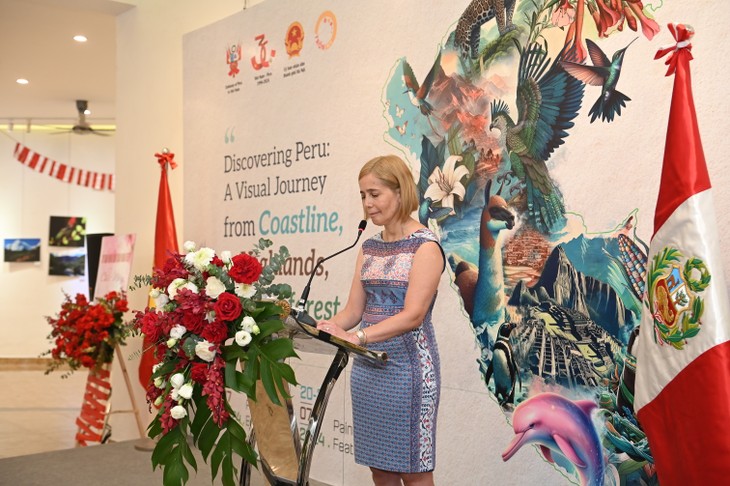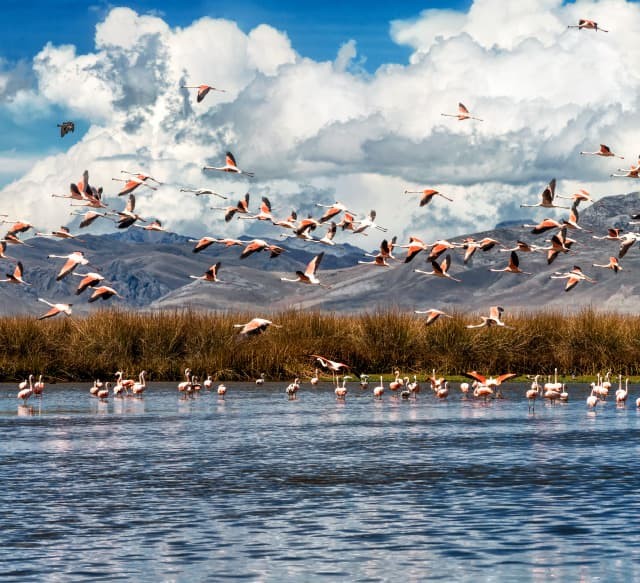(VOVWORLD) - A visual journey to discover Peru at an exhibition “Discovering Peru: A visual journey from coasts to highlands and rainforests” is being held in Hanoi until next Tuesday. The journey explores Peru’s natural landscapes with the world of flora and fauna that Peru stands out thanks to its majestic scenery and rich biodiversity. In Culture Rendezvous this week, we talk with newly-appointed Peruvian Ambassador to Vietnam, Patricia Yolanda Ráez Portocarrero, about the unique features of the Peruvian nature reserves.
 Ambassador Portocarrero at the opening cerermony of the “Discovering Peru: A visual journey from coasts to highlands and rainforests” exhibition in Hanoi on July 18, 2024 (Photo: Peruvian Embassy) Ambassador Portocarrero at the opening cerermony of the “Discovering Peru: A visual journey from coasts to highlands and rainforests” exhibition in Hanoi on July 18, 2024 (Photo: Peruvian Embassy)
|
Bao Tram: Welcome to VOV24/7’s Cultural Rendezvous!
Ambassador Portocarrero: Yes. I’m the ambassador of Peru. I just arrived in May this year and I'm just starting my mission here. I'm very happy to be here in Vietnam!
Bao Tram: I’m very impressed with the visual exhibition and learn that nature reserves are part of Peru’s biodiversity highlights. Could you briefly tell us about the top nature reserves in Peru?
Ambassador Portocarrero: The top nature reserve is probably Manu National Park, in the departments of Madre de Dios and Cusco, because it's so large that it is shared by two departments in Peru. Manu National Park has probably the second largest reserve of birds in the world and the first largest reserve for butterflies in the world. It has more than 1,000 species of birds, and thousands of species of butterflies. So, it's really something that is worth visiting and we're very proud of it.
 Waterbirds taken at Lake Junin, the second largest lake in Peru with a surface area of 530 km2 (Photo: birdwatching.peru.travel) Waterbirds taken at Lake Junin, the second largest lake in Peru with a surface area of 530 km2 (Photo: birdwatching.peru.travel)
|
Bao Tram: As we can learn from the clip, Peru is one of the ten most biodiverse countries and the third country in birds in the world with 1,858 species of which 109 are endemic. Peru has 19% of the birds recorded in the world with 76 natural areas protected preserves 17% of the national territory. What has Peru done to integrate biodiversity into the tourism sector?
Ambassador Portocarrero: Well, we think tourists are looking for something like natural experiences and getting more in contact with nature. To have different experiences, for example, in Peru we have this adventure of living one or two days like Peruvian Indians with a Peruvian family. This is an activity that we know tourists like very much. Currently there is a renewed world consciousness of preserving our planet, our nature, our biodiversity, so what Peru has been doing, for example, is limiting the space or the number of people who visit Machu Picchu, for example. These days I estimate 5,500 to 5,600 people a day, because we also have to follow UNESCO’s rules and principles as this has been designated World Heritage Site.
Bao Tram: Which management or conservation mechanisms has Peru applied to allow tourists to visit while still preserving these areas?
Ambassador Portocarrero: We have to limit for purposes of natural preservation the areas to be visited and the numbers of people who can visit each day. There are certain visitor paths to follow so people cannot just wonder around, to protect the sites. We also have our national service of these natural preservation areas and the main goal in Peru is to protect for future generation of our biodiversity.
Bao Tram: What are specific activities that have been implemented in Peru to realize this effort?
Ambassador Portocarrero: I said, for example, in several sites like in Machu Picchu, there is a limit of number of people who can access the site every day to take proper care, and also to follow the UNESCO Heritage Site rules because Machu Picchu is not the only UNESCO site in Peru. And we have to take protective measures. There are other things that Peru is doing in tourism. For example, in the Amazonian River that starts in Peru, there is a limited number of boats and passengers who can go on the river. There is one company which does a luxury experience on the Amazon River for several days, up to 2 weeks on the Amazon River. So, we invite the people to enjoy this as part of the experience in the vessel observing all the flora and fauna. We also have another activity that is getting very popular: bird watching, because there are so many birds, especially in Manu National Park. As I told you earlier, we really want to position Peru as one of the main countries for bird watching because as I said earlier there are thousands of species and we know that many tourists are interested.
Bao Tram: How have the local communities responded to the government’s measures to conserve natural reserves and their biodiversity?
Ambassador Portocarrero: I think they are the most interested in preserving their own culture, their own traditions, the areas where they live, and their lifestyle. So, from what I know they receive tourists with open arms every visit, and they want to share their day-to-day life with them. And yes they are complying with Peruvian policies to preserve their own towns.
Bao Tram: Thank you, Ambassador Portocarrero for giving VOV this quick interview.
Ambassador Portocarrero: Thank you very much for the Voice of Vietnam